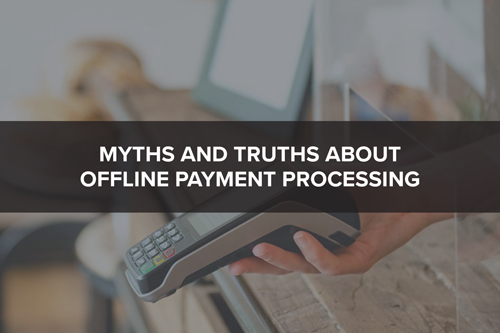In-store transactions continue to trend toward digital payments and away from cash. According to the 2021 Findings from the Diary of Consumer Payment Choice, cash use in the U.S. accounted for only 19 percent of all payments in 2020, 7 percent less than in 2019. With consumers making more payments with credit and debit cards and mobile wallets, your clients are more reliant on an internet connection for approvals – and most need to enable offline payment processing.
Online vs. Offline Payment Processing
 When the customer dips a card or waves a mobile wallet near a card reader to make a payment, the merchant’s system sends a request to the payment processor. Then, the payment processor passes it on to the card brand and card issuing bank for approval. If approved, the transaction goes through; if declined, the merchant must request another form of payment from the customer.
When the customer dips a card or waves a mobile wallet near a card reader to make a payment, the merchant’s system sends a request to the payment processor. Then, the payment processor passes it on to the card brand and card issuing bank for approval. If approved, the transaction goes through; if declined, the merchant must request another form of payment from the customer.
When there isn’t a network connection, merchants can accept payments offline. That means information isn’t transferred to the processor, card brand and issuing bank in real time. Instead, the merchant’s payment technology collects the card information and sends it for authentication when the connection is restored.
Many of your clients may have questions about offline payment processing and the risks associated with it. Help them clear up any misconceptions and make informed decisions about processing offline.
Offline Payment Processing Myths
Common myths about offline payment processing include:
- Offline payments are automatic.
Merchants may assume that if their internet connection is disrupted, their card readers will automatically collect payment data for offline processing. But with some solutions, it won’t. Those payment solutions need to be configured to accept offline payments, so merchants must decide what their Plan B is in advance of any network outage. Solutions that make offline processing easiest for your clients automatically switch to offline mode.
In addition, if your client decides to process payment transactions offline, they’ll also need to establish policies that minimize risk, such as the amount of each sale they will process offline.
- Offline payments aren’t any riskier than online payments.
The truth is offline payment processing is riskier than transactions approved in real time. For example, merchants are responsible for transactions that are declined by the issuing bank when the network connection is restored or chargebacks that occur because EMV cards could not be validated.
Also, there’s a limit to the number of offline payments that can be stored, so lengthy outages could result in lost revenues if the business doesn’t switch to cash-only sales. Merchants also need to bear in mind that offline transactions can expire after some time, so if they aren’t processed within the period set by the issuing bank, the merchant could experience loss or have to go back to the customer for another form of payment.
Fortunately, EMV card data is authenticated offline to ensure cards aren’t counterfeit. However, the merchant won’t know if the card has been reported lost or stolen.
- Merchants get their deposits just as quickly, whether processed offline or online.
Because offline payment transactions are processed when the internet connection is restored, there can be a delay in funds appearing in the merchant’s account. With online transactions, merchants can track payments immediately. However, with offline processing, it can take a few days for payments to appear in the merchant’s system.
- The only option when the network goes down is offline processing.
One alternative to offline processing is using a cellular failover service to maintain connectivity with the payment processor. These solutions automatically switch to 3G, 4G/LTE, or wired or secondary broadband to continue to connect for online processing and real-time approvals.
Debunk the Myths
As trusted business advisors, ISVs and VARs must be totally transparent with their clients to ensure they understand offline payment processing, its risks and benefits. Also, it’s vital for you to partner with a payments company that supports offline processing so that businesses have the ability to keep operating when their internet connectivity is interrupted.



